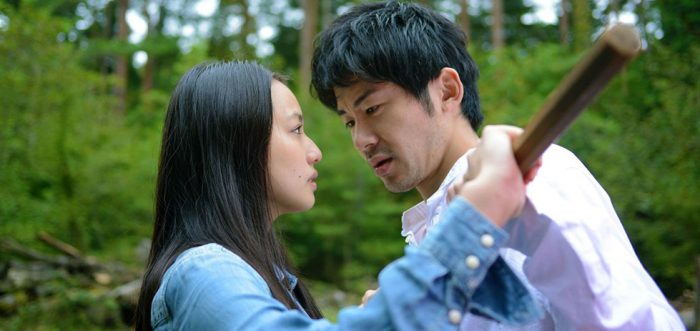
It was fairly unexpected when Nikkatsu announced in March this year that they would be commissioning “five of Japan’s top directors” to make films in the “roman porno” format of the Pink Eiga the studio was known for in the 70s and 80s.1 Perhaps equally surprising is that Akihiko Shiota’s take, Wet Woman in the Wind—the title of which almost seems to amalgamate several films from the genre, from 1973’s Lovers are Wet to 1979’s A Woman with Wet Hair—premiered in the Concorso Internazionale at Locarno several months later.2
Working within the guidelines of a maximum duration of 80 minutes, Akihiko’s film doesn’t waste any time. Within the opening shot, Shiori (Yuki Mamiya)gives the title a fairly literal embodiment as she emerges from the ocean, wearing and quickly removing a wet shirt emblazoned with the slogan “you need tissues for your issues”. The first sex scene of the film happens about 15 minutes in; while these are relatively sparse (read: around every 10-15 minutes) for the first half of the movie, the latter part makes up for lost time as it essentially transforms into a seamless amalgamation of sex scenes, overlapping and intersecting one another feverishly bouncing between sincerity and critique. The film’s protagonist, Kosuke (Nagoaka Tasuku), comes off as a parody of an soul-searching, creative figure; he has a background in theatre, having isolated himself in the woods for inspiration and self-realisation. Initially played with disinterest and distance, Kosuke pushes back Shiori’s overt advances and is met withy feigned acceptance and a foreboding reply that makes the intentions of the film relatively clear: “I’ve locked onto you. Don’t think you can escape me.”
Akihiko’s film is a something that flips the script on a roman porno in many ways but one clear distinction is his reverse-trajectory entrance into the genre: rather than being an entry-point into film production for him, it’s a cinematic exercise given to an established filmmaker in the country. Within this context, there’s a certain stylistic malleability in the film that wasn’t afforded to most directors working in this genre in the ’70s and ’80s. Akihiko’s previous films have explored sexual tensions too, specifically 1999’s Moonlight Whispers, a quirky film where a girl manipulates a boy after discovering a certain fetish of his. Considering this, it mightn’t seem strange to say that it’s almost impossible to look at a film like Wet Woman in the Wind without mentioning the perpetually exquisite shot composition, luscious set design and locations, stunning washed-out forest shots, and a noticeable precision when it comes to the lighting of indoor shots throughout the film.
Wet Woman in the Wind is by all means a ridiculous film, though it maintains a sharp wit that frames an early string of implausible scenarios. In one of the most memorable sequences, Kosuke returns home to find Shiori having sex with someone in his house. Rather than getting angry—or showing any emotion whatsoever, really—he walks outside and makes a coffee, brewing up an extra two for when they emerge. “You’re a surfer”, Kosuke notes, “nice hat”; the surfer replies “Thanks”. This scene shares a lot in common with some of the weirder edges of modern Japanese cinema, with absurdity present in both the comedic and sexual scenes quickly blurring everything together3.
The elephant in the room for making a film like Wet Woman in the Wind is the issues in objectification inherent to the core of the genre itself. While Akihiko’s film positions its disinterested male lead—unable to resist the women around him—as an indictment and satirisation of male fantasies and their detachment from reality in the country, the portrayal of it all is still plagued with plenty of issues; most often, emerging out of what occurs on screen under the banner of criticism. Sexual objectification in the film is rampant, although it remains the case that the objectification is relatively one-sided. The sex itself ranges between comical, self-aware, critical, and by the end of the film occurs almost exclusively out of a competitive sense of madness. In one of the most telling scenes towards the end of the film, a young apprentice with the theatre troupe tells him that her P.E. teacher forced himself upon her in high school, his inability to realise that her description isn’t dissimilar to that of his actions in the previous scene offers a pointed criticism at the deeply damaging, sex-obsessed outlook Kosuke has moved towards throughout the film. The nature of the genre means the veneer of criticism and reflexivity is unlikely to hold as grounds for excuse for all viewers.
There are plenty of ways that Wet Woman in the Wind reads an indictment of male fantasies within the country, which become harsher criticisms in the context of broader trends of sexual repression in Japan.4 There’s no shortage of hilarious moments in Akihiko’s film, though, which work towards justifying Nikkatsu’s revival project. At the same time, Wet Woman in the Wind excels within the genre itself; it is unlikely to be outdone by the other commissioned works and is likely to prove as divisive as it sounds on paper.
